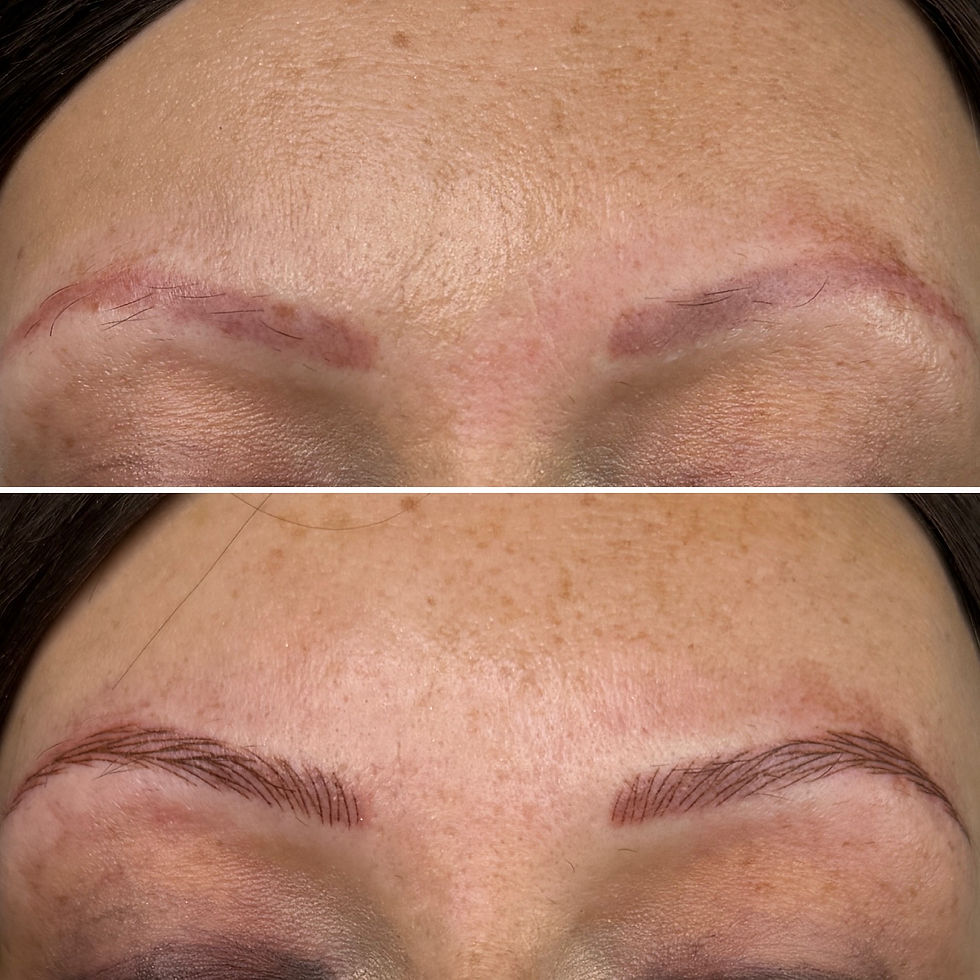**Why Microblading is the Worst Form of Semi-Permanent Makeup**
- elisa f
- Sep 24, 2024
- 4 min read
When it comes to semi-permanent makeup, microblading is one of the most well-known techniques. However, as a cosmetic artist experienced in both microblading and more advanced cosmetic tattooing techniques, I can confidently say that microblading is not just outdated—it can often lead to undesirable results that require costly and painful corrections.
In this blog, I’ll explain why microblading is no longer the go-to option for enhancing your brows and why you might want to consider other alternatives for long-lasting, natural results.
What is microblading?
Microblading is a technique where tiny, hair-like strokes are etched into the skin using a handheld tool with a fine blade. Pigment is deposited into these cuts, mimicking the look of real eyebrow hairs. While it sounds ideal for those seeking fuller brows, the reality is often far from perfect.
The major problems with microblading
While microblading gained popularity for its promise of natural-looking brows, the method has several significant downsides:
1. It’s an outdated technique
Microblading is often seen as an easy skill for new artists to learn, which is why it has become so popular. But just because it’s widely practiced doesn’t mean it’s the best choice. There are now better, more advanced techniques in semi-permanent makeup that provide superior results with fewer risks.
2. High risk of infection and scarring
Microblading involves making tiny cuts in the skin to deposit pigment. This leaves a large surface area exposed during the healing process, leading to significant scabbing. Not only does this increase the chances of infection, but the healing process can also be uncomfortable and prolonged. In some cases, the result is painful scarring.

This is not my work of course! In the above example you can see two common results from microblading. The top picture is a bad shape and incorrect hairstroke placement but it's very faded already. This won't last more than 2-3 months. The bottom picture is an example of hairstrokes that have been placed too deep. The lines are thick, blurry and very dark. She will need laser tattoo removal done as these results tend not to fade at all and are more like an actual tattoo.
3. Poor pigment retention
One of the biggest frustrations with microblading is how quickly the pigment fades. For many people, the pigment is largely removed during the healing process, leaving little to no visible result. While it’s true that the pigment is meant to fade naturally over time, in some cases it fades too quickly—leaving clients disappointed after investing in what was supposed to be a long-lasting treatment.
4. Blurring and discolouration
If the pigment does stay, the results are often less than ideal. As the skin heals, the delicate strokes created by the microblade tend to blur. What was intended to mimic fine hair strokes can become thick, blurry lines. Worse, the pigment can change color over time, turning blue or grey. This is especially common if the microblade was pushed too deep into the skin in an effort to retain pigment.
5. Painful corrections and removal
Clients who experience these issues often come to me seeking corrections. Unfortunately, correcting poorly done microblading is not always easy. In some cases, laser tattoo removal is needed to completely remove the botched brows. This process is painful, costly, and can take months to achieve clear results. I frequently see clients who are left with scar tissue and regret from their microblading experience.
Is microblading ever a good option?
While some people with flawless skin may have good results from microblading, the technique is far from universally effective. If you have oily skin, sensitive skin, or are prone to scarring, microblading is likely to cause more harm than good.
The better alternative: cosmetic tattooing (nano brows)
Fortunately, there are more reliable and advanced techniques available today. Cosmetic tattooing, often referred to as nano brows, offers a gentler, more precise method for enhancing your brows. Using a cosmetic tattoo machine, pigment is softly layered into the skin to create hairstrokes that are even more natural looking than microblading.
I’ve helped many clients correct the faded, blurred results of microblading by performing cosmetic tattooing. The results are more natural, the healing time is shorter and the results last far longer.
Nano brows are finally getting the attention and recognition they deserve!
Below is an example of where I've been able to correct previously done microblading with Nano Brows.

Final thoughts
Microblading might be one of the most well-known forms of semi-permanent makeup, but that doesn’t mean it’s the best. The risks of infection, scarring, poor pigment retention, and the need for painful corrections make it a technique that is quickly becoming outdated. If you’re looking for long-lasting, natural-looking brows, consider opting for a more advanced technique like cosmetic tattooing. Your skin—and your brows—will thank you!
Let me know your experiences with microblading in the comments below. Have you had to deal with any of the issues mentioned? I'd love to hear from you!

Comments